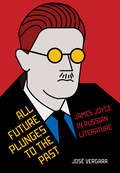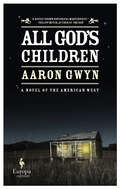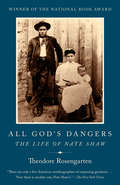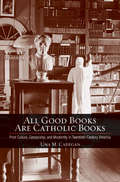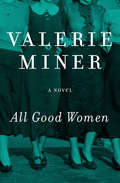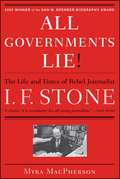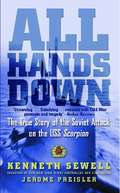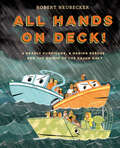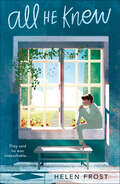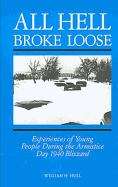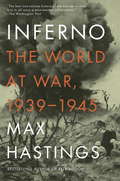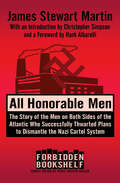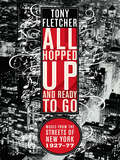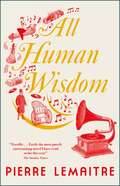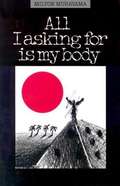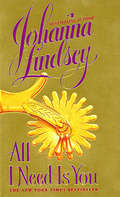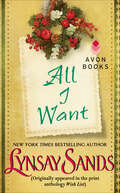- Table View
- List View
All Future Plunges to the Past: James Joyce in Russian Literature (NIU Series in Slavic, East European, and Eurasian Studies)
by José VergaraAll Future Plunges to the Past explores how Russian writers from the mid-1920s on have read and responded to Joyce's work. Through contextually rich close readings, José Vergara uncovers the many roles Joyce has occupied in Russia over the last century, demonstrating how the writers Yury Olesha, Vladimir Nabokov, Andrei Bitov, Sasha Sokolov, and Mikhail Shishkin draw from Joyce's texts, particularly Ulysses and Finnegans Wake, to address the volatile questions of lineages in their respective Soviet, émigré, and post-Soviet contexts. Interviews with contemporary Russian writers, critics, and readers of Joyce extend the conversation to the present day, showing how the debates regarding the Irish writer's place in the Russian pantheon are no less settled one hundred years after Ulysses.The creative reworkings, or "translations," of Joycean themes, ideas, characters, plots, and styles made by the five writers Vergara examines speak to shifting cultural norms, understandings of intertextuality, and the polarity between Russia and the West. Vergara illuminates how Russian writers have used Joyce's ideas as a critical lens to shape, prod, and constantly redefine their own place in literary history.All Future Plunges to the Past offers one overarching approach to the general narrative of Joyce's reception in Russian literature. While each of the writers examined responded to Joyce in an individual manner, the sum of their methods reveals common concerns. This subject raises the issue of cultural values and, more importantly, how they changed throughout the twentieth century in the Soviet Union, Russian emigration, and the post-Soviet Russian environment.
All God's Children Need Travelling Shoes
by Dr Maya AngelouA memoir about home and belonging, from the author of I KNOW WHY THE CAGED BIRD SINGS'A brilliant writer, a fierce friend and a truly phenomenal woman' BARACK OBAMAMaya Angelou's five volumes of autobiography, beginning with I KNOW WHY THE CAGED BIRD SINGS, are a testament to the talents and resilience of this extraordinary writer. Loving the world, she also knows its cruelty. As a black woman she has known discrimination and extreme poverty, but also hope, joy, achievement and celebration. In the fifth volume, Maya Angelou emigrates to Ghana only to discover that 'you can't go home again' but she comes to a new awareness of love and friendship, civil rights and slavery - and the myth of mother Africa.'She moved through the world with unshakeable calm, confidence and a fierce grace . . . She will always be the rainbow in my clouds' OPRAH WINFREY'She was important in so many ways. She launched African American women writing in the United States. She was generous to a fault. She had nineteen talents - used ten. And was a real original. There is no duplicate' TONI MORRISON
All God's Children: A Novel of the American West
by Aaron GwynThis sweeping novel set in the province of Texas is “a powerful depiction of the rough realities of frontier life [and] the vicious influence of racism” (The New York Times).Finalist for the Reading the West Book Award for FictionIn 1827, Duncan Lammons, a disgraced young man from Kentucky, sets out to join the American army in the province of Texas, hoping that here he may live—and love—as he pleases. That same year, Cecelia, a young slave in Virginia, runs away for the first time.Soon infamous for her escape attempts, Cecelia continues to drift through the reality of slavery—until she encounters frontiersman Sam Fisk, who rescues her from a slave auction in New Orleans. In spite of her mistrust, Cecelia senses an opportunity for freedom, and travels with Sam to Texas, where he has a homestead. In this new territory, where the law is an instrument for the cruel and the wealthy, they begin an unlikely life together, unaware that their fates are intertwined with those of Sam’s former army mates, including Duncan Lammons, a friend—and others who harbor dangerous dreams of their own.This “swift and skillful Western” takes its place among the great stories that recount the country’s fight for freedom—one that makes us want to keep on with the struggle (The Wall Street Journal).“Gwyn creates an overwhelmingly visceral and emotionally rich narrative amid Texas’s complex path to statehood . . . This is a masterpiece of western fiction in the tradition of Cormac McCarthy and James Carlos Blake.” —Publishers Weekly (starred review)“It’s always a pleasure to discover another superb writer who had not been on my radar . . . many scenes pulse with tension, tenderness or both.” —Minneapolis Star Tribune
All God's Children: How Confronting Buried History Can Build Racial Solidarity
by Terence LesterThe more you understand someone's history, the better you can see their humanity. This is true for individuals as well as for society at large. Race relations have suffered because of the erasure of important Black history and cultural context. As we fill in the gaps of our collective knowledge, communities can grow in understanding, empathy, and solidarity. Terence Lester shares the buried history of the struggles Black people have faced against unjust systems. He tells powerful stories of courage, injustice, pain, and triumph, including ones from his own history. He also unpacks the sociological and cultural dynamics of unconscious bias and inattentional ignorance that keep us apart, and how they can be overcome. This honest account of what it's like to be Black in America paves the way for the church to move beyond showing support from a distance toward loving one another in long-term solidarity, advocacy, and friendship.
All God's Children: The Bosket Family and the American Tradition of Violence
by Fox ButterfieldA timely reissue of Fox Butterfield's masterpiece, All God's Children, a searing examination of the caustic cumulative effect of racism and violence over 5 generations of black Americans. Willie Bosket is a brilliant, violent man who began his criminal career at age five; his slaying of two subway riders at fifteen led to the passage of the first law in the nation allowing teenagers to be tried as adults. Butterfield traces the Bosket family back to their days as South Carolina slaves and documents how Willie is the culmination of generations of neglect, cruelty, discrimination and brutality directed at black Americans. From the terrifying scourge of the Ku Klux Klan during Reconstruction to the brutal streets of 1970s New York, this is an unforgettable examination of the painful roots of violence and racism in America.
All God's Dangers: The Life Of Nate Shaw
by Theodore RosengartenClassic of oral history tells the life story of Nate Shaw, an illiterate black sharecropper who stood up against white farmers in the 1930's and spent time in prison for it. Includes much folklore and information about rural life.<P><P> Winner of the National Book Award
All Good Books Are Catholic Books: Print Culture, Censorship, and Modernity in Twentieth-Century America
by Una M. CadeganUntil the close of the Second Vatican Council in 1965, the stance of the Roman Catholic Church toward the social, cultural, economic, and political developments of the twentieth century was largely antagonistic. Naturally opposed to secularization, skeptical of capitalist markets indifferent to questions of justice, confused and appalled by new forms of high and low culture, and resistant to the social and economic freedom of women—in all of these ways the Catholic Church set itself up as a thoroughly anti-modern institution. Yet, in and through the period from World War I to Vatican II, the Church did engage with, react to, and even accommodate various aspects of modernity. In All Good Books Are Catholic Books, Una M. Cadegan shows how the Church’s official position on literary culture developed over this crucial period.The Catholic Church in the United States maintained an Index of Prohibited Books and the National Legion of Decency (founded in 1933) lobbied Hollywood to edit or ban movies, pulp magazines, and comic books that were morally suspect. These regulations posed an obstacle for the self-understanding of Catholic American readers, writers, and scholars. But as Cadegan finds, Catholics developed a rationale by which they could both respect the laws of the Church as it sought to protect the integrity of doctrine and also engage the culture of artistic and commercial freedom in which they operated as Americans. Catholic literary figures including Flannery O’Connor and Thomas Merton are important to Cadegan’s argument, particularly as their careers and the reception of their work demonstrate shifts in the relationship between Catholicism and literary culture. Cadegan trains her attention on American critics, editors, and university professors and administrators who mediated the relationship among the Church, parishioners, and the culture at large.
All Good Women: A Novel
by Valerie MinerAs World War II rages abroad, a group of women forge the bonds of sisterhood in AmericaIn 1938, while tensions in Europe are reaching a boiling point, four young women with big ambitions enter secretarial school in San Francisco. Motivated to attain the financial stability that eluded their parents, they go to battle for their futures. Moira, of Scottish descent, dreams of being an actress. Ann yearns for the education her Jewish immigrant parents provided for her brother, but not for her. Japanese American Wanda experiences firsthand the racial injustices running rampant in the United States. And Teddy, who left the Dust Bowl for sunny California, comes to startling realizations about herself as the war progresses. These women will be both buoyed and challenged by their dreams, experiencing love, loss, and everything in between. Against the backdrop of a nation gripped by fear and paranoia, Miner eloquently captures the spirit of wartime on the home front.
All Governments Lie: The Life and Times of Rebel Journalist I. F. Stone
by Myra MacphersonHere, for the first time, acclaimed journalist and author Myra MacPherson brings the legendary Stone into sharp focus. Rooted in fifteen years of research, this monumental biography includes information from newly declassified international documents and Stone's unpublished five-thousand-page FBI file, as well as personal interviews with Stone and his wife, Esther; with famed modern thinkers; and with the best of today's journalists. It illuminates the vast sweep of turbulent twentieth-century history as well as Stone's complex and colorful life. The result is more than a masterful portrait of a remarkable character; it's a far-reaching assessment of journalism and its role in our culture.
All Hands Down
by Kenneth Sewell Jerome PreislerFrom the author of Red Star Rogue, the controversial account of the destruction of the USS Scorpion, the nuclear submarine that sank with ninety-nine crewmen aboard in 1968--an event that was officially attributed to accident. The tragedy of the USS Scorpion--and the lingering mystery of what caused it to sink in 10,000 feet of water on the eastern edge of the Sargasso Sea--has been widely written about. All Hands Down shows how the Soviet plot to exact revenge for the loss of a Russian sub was executed and explains why the truth of the attack has been officially denied for forty years. Sewell and Preisler debunk various official explanations for the tragedy and bring to life the personal stories of some of the men who were lost when Scorpion went to the bottom.naval communications. In March, a Soviet sub, K-129, mysteriously sank near Hawaii, hundreds of miles from its normal station in the Pacific. Soviet naval leaders mistakenly believed that a U.S. submarine was to blame for the loss, and they planned revenge. A trap was set: several Soviet vessels were gathered in the Atlantic, acting suspiciously. It would be only a matter of time before a U.S. sub was sent to investigate. That sub was Scorpion. Using the top-secret codes and the deciphering machine, the Soviets could intercept and decode communication between the Navy and Scorpion, the final element in carrying out the planned attack. All Hands Down shows how the Soviet plan was executed and explains why the truth of the attack has been officially denied for forty years. Sewell and Preisler debunk various official explanations for the tragedy and bring to life the personal stories of some of the men who were lost when Scorpion went to the bottom. This true story, finally told after exhaustive research, is more exciting than any novel.
All Hands on Deck!: A Deadly Hurricane, a Daring Rescue, and the Origin of the Cajun Navy
by Robert NeubeckerA heroic tale of boats, large and small, teaming up and lending a hand in a time of need, based on the true story of a community that came together to rescue survivors of Hurricane Katrina.When the wind is high and the barometer is low, it can mean only one thing: Hurricane! In the aftermath of a terrible storm, a coastal community is left in shambles, with thousands of people stranded on cars or rooftops. The Coast Guard is stretched to its limit, and all along the coast, schooners and sloops and speedboats wonder "What can I do? I am only one little boat." But by working together, even the littlest boats can make a difference.Based on the true story of the "Cajun Navy" that came together in the aftermath of Hurricane Katrina and has continued to assist in rescue efforts after every major hurricane to strike the Gulf Coast in the years since, this tale of courage and community will inspire readers of all ages to step up and do their part.
All He Desires
by Anthea LawsonFar from home and her noble relatives, Miss Caroline Huntington has been injured in a fall from her horse. Called to her side, Alex Trentham knows he must assist her, though he has not practiced as a physician for a long while. Just to see so lovely a woman in a state of undress is a hard test of his self-control. Caroline is all that is warm and feminine, beautiful and pure. Brave to a fault, she does not flinch under his hands, and soon she is on the mend. To hide his feelings becomes impossible and Alex cannot. Her radiant innocence is dangerous to a worldly man ... and she seems achingly eager to experience all the pleasure he could show her ...
All He Desires
by Anthea LawsonAnd Then He Kissed Her. Far from home and her noble relatives, Miss Caroline Huntington has been injured in a fall from her horse. Called to her side, Alex Trentham knows he must assist her, though he has not practiced as a physician for a long while. Just to see so lovely a woman in a state of undress is a hard test of his self-control. Caroline is all that is warm and feminine, beautiful and pure. Brave to a fault, she does not flinch under his hands, and soon she is on the mend. To hide his feelings becomes impossible and Alex cannot. Her radiant innocence is dangerous to a worldly man. . .and she seems achingly eager to experience all the pleasure he could show her. . .
All He Knew
by Helen FrostA 2021 Scott O'Dell Award WinnerA Society of Midland Authors Winner in Children's FictionA Bank Street Best Book of the Year 2021A novel in verse about a young deaf boy during World War II, the sister who loves him, and the conscientious objector who helps him. Inspired by true events.Henry has been deaf from an early age—he is intelligent and aware of langauge, but by age six, he has decided it's not safe to speak to strangers. When the time comes for him to start school, he is labeled "unteachable." Because his family has very little money, his parents and older sister, Molly, feel powerless to help him. Henry is sent to Riverview, a bleak institution where he is misunderstood, underestimated, and harshly treated.Victor, a conscientious objector to World War II, is part of a Civilian Public Service program offered as an alternative to the draft. In 1942, he arrives at Riverview to serve as an attendant and quickly sees that Henry is far from unteachable—he is brave, clever, and sometimes mischievous. In Victor's care, Henry begins to see how things can change for the better. Heartbreaking and ultimately hopeful, Helen Frost's All He Knew is inspired by true events and provides sharp insight into a little-known element of history.
All Hell Broke Loose: Experiences of Young People During the Armistice Day 1940 Blizzard
by William H. Hull(Introduction) After going through all the thousands of hours it takes to write a book, an author sometimes asks himself why he did it? That's a fair question. I wasn't even in the state of Minnesota on that fateful day of November 11, 1940. I was a graduate student at Southern Methodist University in Dallas and a steady reader of the Dallas Morning News. The story must have been covered by that fine newspaper but, if so, it made no impression on me. Later when I became a Minnesotan I began to hear stories of this horrible storm that killed so many people. Through the 39 years I have considered myself a Minnesotan I have frequently thought what a shame that all of those stories about this particular storm weren't written, so I decided to act for the good of history and before these people died. After all, that storm was 45 years ago at this writing. It seemed to me that people would want to know what it was like to be living on a farm with cattle and chickens to take care of, to be facing possible death on a small island in the Mississippi while duck hunting, to fight for survival in snow that seemed to be up to the armpits in northern Minnesota while deer hunting, and to be immovably caught in the "loop" of a big city like Minneapolis or St. Paul with no place to spend the night and no way to get home. These are the experiences about which these many Minnesotans have written. Speaking for all of them, I hope you enjoy their tales and realize how agonizing it was for many people- those who were fortunate enough to live through it. My only regret is that so many of the 500 + experiences received and edited had to be eliminated to restrict the physical size of the book. After repeatedly selecting from the anecdotes received, the final cutting eliminated sixty percent of those I wished to include. William Hull
All Hell Let Loose: The World at War, 1939-1945
by Max HastingsFrom one of our finest military historians, a monumental work that shows us at once the truly global reach of World War II and its deeply personal consequences. World War II involved tens of millions of soldiers and cost sixty million lives--an average of twenty-seven thousand a day. For thirty-five years, Max Hastings has researched and written about different aspects of the war. Now, for the first time, he gives us a magnificent, single-volume history of the entire war. Through his strikingly detailed stories of everyday people--of soldiers, sailors and airmen; British housewives and Indian peasants; SS killers and the citizens of Leningrad, some of whom resorted to cannibalism during the two-year siege; Japanese suicide pilots and American carrier crews--Hastings provides a singularly intimate portrait of the world at war. He simultaneously traces the major developments--Hitler's refusal to retreat from the Soviet Union until it was too late; Stalin's ruthlessness in using his greater population to wear down the German army; Churchill's leadership in the dark days of 1940 and 1941; Roosevelt's steady hand before and after the United States entered the war--and puts them in real human context.Hastings also illuminates some of the darker and less explored regions under the war's penumbra, including the conflict between the Soviet Union and Finland, during which the Finns fiercely and surprisingly resisted Stalin's invading Red Army; and the Bengal famine in 1943 and 1944, when at least one million people died in what turned out to be, in Nehru's words, "the final epitaph of British rule" in India. Remarkably informed and wide-ranging, Inferno is both elegantly written and cogently argued. Above all, it is a new and essential understanding of one of the greatest and bloodiest events of the twentieth century.From the Hardcover edition.
All Honorable Men: The Story of the Men on Both Sides of the Atlantic Who Successfully Thwarted Plans to Dismantle the Nazi Cartel System (Forbidden Bookshelf #21)
by James Stewart MartinA scathing attack on Wall Street&’s illegal ties to Nazi Germany before WWII—and the postwar whitewashing of Nazi business leaders by the US government Prior to World War II, German industry was controlled by an elite group who had used their money and influence to help bring the Nazi Party to power. After the Allies had successfully occupied Germany and removed the Third Reich, the process of reconstructing the devastated nation&’s economy began under supervision of the US government. James Stewart Martin, who had assisted the Allied forces in targeting key areas of German industry for aerial bombardment, returned to Germany as the director of the Division for Investigation of Cartels and External Assets in American Military Government, a position he held until 1947. Martin was to break up the industrial machine these cartels controlled and investigate their ties to Wall Street. What he discovered was shocking. Many American corporations had done business with German corporations who helped fund the Nazi Party, despite knowing what their money was supporting. Effectively, Wall Street&’s greed had led them to aid Hitler and hinder the Allied effort. Martin&’s efforts at decartelization were unsuccessful though, largely due to hindrance from his superior officer, an investment banker in peacetime. In conclusion, he said, &“We had not been stopped in Germany by German business. We had been stopped in Germany by American business.&” This exposé on economic warfare, Wall Street, and America&’s military industrial complex includes a new introduction by Christopher Simpson, author of Blowback:America&’s Recruitment of Nazis and Its Destructive Impact on Our Domestic and Foreign Policy, and a new foreword from investigative journalist Hank Albarelli.
All Hopped Up and Ready to Go: Music from the Streets of New York 1927-77
by Tony FletcherA penetrating and entertaining exploration of New York's music scene from Cubop through folk, punk, and hip-hop. From Tony Fletcher, the acclaimed biographer of Keith Moon, comes an incisive history of New York's seminal music scenes and their vast contributions to our culture. Fletcher paints a vibrant picture of mid-twentieth-century New York and the ways in which its indigenous art, theater, literature, and political movements converged to create such unique music. With great attention to the colorful characters behind the sounds, from trumpet player Dizzy Gillespie to Tito Puente, Bob Dylan, and the Ramones, he takes us through bebop, the Latin music scene, the folk revival, glitter music, disco, punk, and hip-hop as they emerged from the neighborhood streets of Harlem, the East and West Village, Brooklyn, the Bronx, and Queens. All the while, Fletcher goes well beyond the history of the music to explain just what it was about these distinctive New York sounds that took the entire nation by storm.
All Human Wisdom
by Pierre Lemaitre"Terrific . . . Easily the most purely entertaining novel I have read so far this year" David Mills, The Sunday Times"A really excellent suspense novelist" Stephen KingThe second volume of Pierre Lemaitre's enthralling, award-winning between-the-wars trilogyIn 1927, the great and the good of Paris gather at the funeral of the wealthy banker, Marcel Péricourt. His daughter, Madeleine, is poised to take over his financial empire (although, unfortunately, she knows next to nothing about banking). More unfortunately still, when Madeleine's seven-year-old son, Paul, tumbles from a second floor window of the Péricourt mansion on the day of his grandfather's funeral, and suffers life-changing injuries, his fall sets off a chain of events that will reduce Madeleine to destitution and ruin in a matter of months.Using all her reserves of ingenuity, resourcefulness, and a burning desire for retribution, Madeleine sets about rebuilding her life. She will be helped by an ex-Communist fixer, a Polish nurse who doesn't speak a word of French, a brainless petty criminal with a talent for sabotage, an exiled German Jewish chemist, a very expensive forger, an opera singer with a handy flair for theatrics, and her own son with ideas for a creative new business to take Paris by storm.A brilliant, imaginative, free-falling caper through between-the-wars Paris, and a portrait of Europe on the edge of disaster.Translated from the French by Frank WynneFrom the reviews for The Great Swindle"The most purely enjoyable book I've read this year" Jake Kerridge, Sunday Telegraph"The vast sweep of the novel and its array of extraordinary secondary characters have attracted comparisons with the works of Balzac. Moving, angry, intelligent - and compulsive" Marcel Berlins, The Times
All Human Wisdom
by Pierre Lemaitre"Terrific . . . Easily the most purely entertaining novel I have read so far this year" David Mills, The Sunday Times"A really excellent suspense novelist" Stephen KingThe second volume of Pierre Lemaitre's enthralling, award-winning between-the-wars trilogyIn 1927, the great and the good of Paris gather at the funeral of the wealthy banker, Marcel Péricourt. His daughter, Madeleine, is poised to take over his financial empire (although, unfortunately, she knows next to nothing about banking). More unfortunately still, when Madeleine's seven-year-old son, Paul, tumbles from a second floor window of the Péricourt mansion on the day of his grandfather's funeral, and suffers life-changing injuries, his fall sets off a chain of events that will reduce Madeleine to destitution and ruin in a matter of months.Using all her reserves of ingenuity, resourcefulness, and a burning desire for retribution, Madeleine sets about rebuilding her life. She will be helped by an ex-Communist fixer, a Polish nurse who doesn't speak a word of French, a brainless petty criminal with a talent for sabotage, an exiled German Jewish chemist, a very expensive forger, an opera singer with a handy flair for theatrics, and her own son with ideas for a creative new business to take Paris by storm.A brilliant, imaginative, free-falling caper through between-the-wars Paris, and a portrait of Europe on the edge of disaster.Translated from the French by Frank WynneFrank Wynne is an award-winning writer and translator. His previous translations include works by Virginie Despentes, Javier Cercas and Michel Houellebecq. His translation of Vernon Subutex I was shortlisted for the Man Booker International Prize.With the support of the Creative Europe Programme of the European UnionFrom the reviews for The Great Swindle"The most purely enjoyable book I've read this year" Jake Kerridge, Sunday Telegraph"The vast sweep of the novel and its array of extraordinary secondary characters have attracted comparisons with the works of Balzac. Moving, angry, intelligent - and compulsive" Marcel Berlins, The Times
All I Asking For Is My Body
by Milton MurayamaThe story of two Japanese boys Tosh and his brother growing up on a Hawaiian sugar plantation, finding it difficult to build a life as their parents have gigantic debts as a result of misfortune and exploitative labor conditions.
All I Could Be: My Story as a Woman Warrior in Iraq
by Miyoko HikijiThis inaugural account, during the onset of the Global War on Terrorism, by a female National Guard soldier provides evidence of the vitality of female fighters.It pays tribute to the two soldiers in her unit that lost their lives, and shows how love can be more vital in the desert than in water. This story exposes the comradeship, intimacy, cowardice and humor of soldiers living in physical and emotional grit.Through the candid telling of her encounters with battle buddies, the Iraqi people and enemy prisoners of war, Hikiji adds the timely, unexpected and fresh perspective about the Iraq war that readers are thirsting for.
All I Need Is You (Straton Family #2)
by Johanna LindseyHeadstrong Casey Straton inherited her mother's beautiful eyes and her father's stubborn temperament. So when she is denied the responsibility of running her grandfather's ranch despite her unladylike prowess at roping, riding and shooting the high-spirited hellion storms away from her Texas home, determined to prove she can do much more than "woman's work." Successful businessman Damian Rutledge III came West for vengeance. But though he possesses a powerful physique and unwavering courage, the handsome Eastern "dude" would have surely been lost in the wild west without the timely intervention of a half-pint bounty hunter called "Ed." There is more to this fearless gunslinger than first meets the eye, however. And when Damian discovers his rescuer is, in fact, a stunningly sensuous young lady named "Casey' in disguise, he realises dial there are going to be very serious complications on the rocky trail that is leading them both toward a dangerous, irrepressible love. Johanna Lindsey's enchanting romantic adventure All I Need Is You is the sequel to her immensely popular A Heart So Wild. Lovely and tempestuous Casey Straton the headstrong child of Chandros Straton and Courtney Harte leaves her Texas home determined to prove to her parents that she can do more than "woman's work." Successful businessman Damien Rutledge III came west looking for vengeance. But though he is strong and fearless, the handsome Eastern "dude" would have surely been lost in the wild West were it not for the timely intervention of a half-pint bounty hunter called "Kid." but when Damien discovers his rescuer is, in fact, a stunningly sensuous young lady named Casey in disguise, he realises that there are going to be very serious complications on the rocky trail that is leading them both toward a dangerous, irrepressible love.
All I Want
by Lynsay SandsA lady trying to save her family from poverty falls for her enemy in this classic Regency romance novella from a New York Times bestselling author.All Lady Prudence wants for Christmas is to keep her family out of the poorhouse. Easily done if her father would stop gambling away what little is left of their fortune. But when Pru arrives at London’s most notorious gaming hall to haul her father home, she marches right into its wickedly handsome and utterly infuriating proprietor, Lord Stockton—who has no intention of letting a lady into his establishment. With that wicked man in her way, Pru knows she’s going to need nothing short of a miracle to make her Christmas wish come true.
All I Want Is Loving You: Popular Female Singers of the 1950s (American Made Music Series)
by Steve BergsmanIn All I Want Is Loving You: Popular Female Singers of the 1950s, author Steve Bergsman focuses on the white, female artists of the 1950s, a time that predated the chart-topping girl groups of the early 1960s. These popular performers, many of whom graduated out of the big bands of the 1940s, impacted popular music in a huge way. As the last bastion of traditional pop and the last sirens of swing, they undeniably shined in the spotlight. Yet these singers’ fame dimmed relatively quickly with the advent of rock ’n’ roll. A fortunate few, like Doris Day, Patti Page, Peggy Lee, and Debbie Reynolds, experienced some of their biggest hits in the late 1950s, and Eydie Gormé broke out in the 1960s. The luckiest, including Dinah Shore and Rosemary Clooney, ventured to television with varying degrees of success. Others would become major attractions at nightclubs in Las Vegas or, like Teresa Brewer, shift into the jazz world.Though the moment did not last, these performers were best-selling singers, darlings of the disk jockeys, and the frenetic heartbeat of fan clubs during their heyday. In a companion volume, Bergsman has written the history of African American women singers of the same era. These Black musicians transitioned more easily as a new form of music, rock ’n’ roll, skyrocketed in popularity. In both books, Bergsman reintroduces readers to these talented singers, offering a thorough look at their work and turning up the volume on their legacy.
